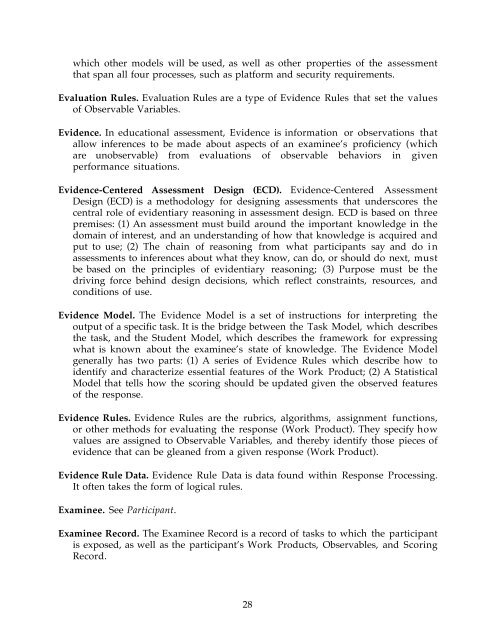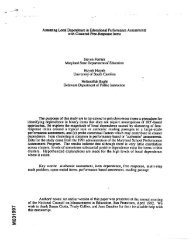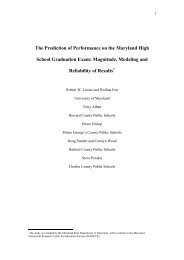A Brief Introduction to Evidence-Centered Design CSE Report 632 ...
A Brief Introduction to Evidence-Centered Design CSE Report 632 ...
A Brief Introduction to Evidence-Centered Design CSE Report 632 ...
Create successful ePaper yourself
Turn your PDF publications into a flip-book with our unique Google optimized e-Paper software.
which other models will be used, as well as other properties of the assessmentthat span all four processes, such as platform and security requirements.Evaluation Rules. Evaluation Rules are a type of <strong>Evidence</strong> Rules that set the valuesof Observable Variables.<strong>Evidence</strong>. In educational assessment, <strong>Evidence</strong> is information or observations thatallow inferences <strong>to</strong> be made about aspects of an examinee’s proficiency (whichare unobservable) from evaluations of observable behaviors in givenperformance situations.<strong>Evidence</strong>-<strong>Centered</strong> Assessment <strong>Design</strong> (ECD). <strong>Evidence</strong>-<strong>Centered</strong> Assessment<strong>Design</strong> (ECD) is a methodology for designing assessments that underscores thecentral role of evidentiary reasoning in assessment design. ECD is based on threepremises: (1) An assessment must build around the important knowledge in thedomain of interest, and an understanding of how that knowledge is acquired andput <strong>to</strong> use; (2) The chain of reasoning from what participants say and do inassessments <strong>to</strong> inferences about what they know, can do, or should do next, mustbe based on the principles of evidentiary reasoning; (3) Purpose must be thedriving force behind design decisions, which reflect constraints, resources, andconditions of use.<strong>Evidence</strong> Model. The <strong>Evidence</strong> Model is a set of instructions for interpreting theoutput of a specific task. It is the bridge between the Task Model, which describesthe task, and the Student Model, which describes the framework for expressingwhat is known about the examinee’s state of knowledge. The <strong>Evidence</strong> Modelgenerally has two parts: (1) A series of <strong>Evidence</strong> Rules which describe how <strong>to</strong>identify and characterize essential features of the Work Product; (2) A StatisticalModel that tells how the scoring should be updated given the observed featuresof the response.<strong>Evidence</strong> Rules. <strong>Evidence</strong> Rules are the rubrics, algorithms, assignment functions,or other methods for evaluating the response (Work Product). They specify howvalues are assigned <strong>to</strong> Observable Variables, and thereby identify those pieces ofevidence that can be gleaned from a given response (Work Product).<strong>Evidence</strong> Rule Data. <strong>Evidence</strong> Rule Data is data found within Response Processing.It often takes the form of logical rules.Examinee. See Participant.Examinee Record. The Examinee Record is a record of tasks <strong>to</strong> which the participantis exposed, as well as the participant’s Work Products, Observables, and ScoringRecord.28






